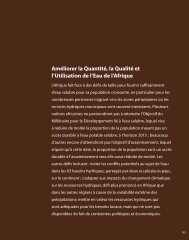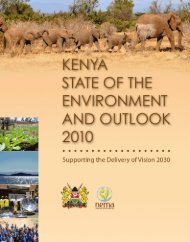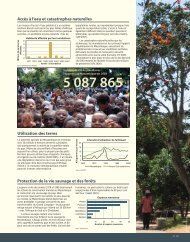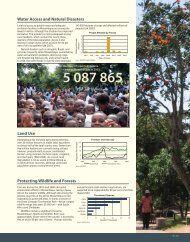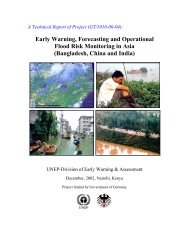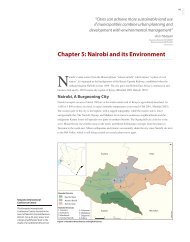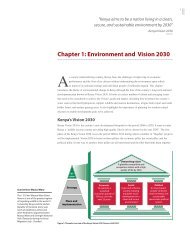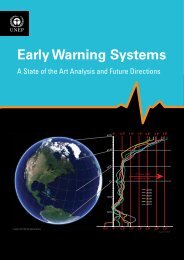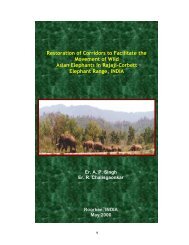Uganda Atlas of Our Changing Environment - GRID-Arendal
Uganda Atlas of Our Changing Environment - GRID-Arendal
Uganda Atlas of Our Changing Environment - GRID-Arendal
You also want an ePaper? Increase the reach of your titles
YUMPU automatically turns print PDFs into web optimized ePapers that Google loves.
Soils: Changes . Classification and Nomenclature<br />
Soils Types<br />
Soil Type Sub Type Area (Km 2 )<br />
Andosols Leptic/Skeletic 5,751<br />
Table 4: Soil Types and Productivity status in <strong>Uganda</strong><br />
Changes<br />
Melanic 63<br />
Arenosols 5,579<br />
Calcisols 204<br />
Ferralsols Acric 43,180<br />
Lixic 24,392<br />
Gleysols 24,019<br />
Histosols 580<br />
Leptosols 22,086<br />
Luvisols 5,275<br />
Nitisols 3,907<br />
Planosols 1,735<br />
Plinthosols Petric 35,205<br />
Regosols Dystric 5,072<br />
Eutric 8,085<br />
Vertisols 19,066<br />
Over the years, food production has been characterized<br />
by subsistence farming. A subsistence production<br />
system usually focuses on maximizing short term pr<strong>of</strong>it<br />
which promotes consuming and depleting natural stocks<br />
<strong>of</strong> plant nutrients. Such a farming system has resulted<br />
in soil fertility degradation through nutrient mining.<br />
In the past, when <strong>Uganda</strong>’s population was still low,<br />
lost soil fertility was restored through long periods <strong>of</strong><br />
fallows. With an average land holding <strong>of</strong> about 2 ha<br />
per household today, fallows are no longer practical.<br />
Research has demonstrated that fertilizer inputs and<br />
appropriate land management practices are important<br />
components <strong>of</strong> technology required to maintain or<br />
improve soil fertility in <strong>Uganda</strong> (P. Ndeki et al).<br />
Severe soil erosion on Mt. Elgon slopes in Kapchorwa District, resulting from<br />
loss <strong>of</strong> vegetation cover and leading to heavy siltation <strong>of</strong> River Ngenge (2005)<br />
Classification and Nomenclature<br />
The major criteria in soil classification are the physical<br />
and chemical characteristics. Physical characteristics<br />
include factors such as parent rock, texture, structure,<br />
location, depth, colour, and topography, while chemical<br />
characteristics include pH, base composition, base<br />
saturation, and Cation Exchange Capacity (CEC). Going by<br />
those criteria, 13 major classes (some with sub classes)<br />
have been identified at national level (see Table 4).<br />
The earlier nomenclature <strong>of</strong> soils in <strong>Uganda</strong> was based on<br />
the catena system, in which units were assigned names <strong>of</strong><br />
the most prominent town or centre in the area. This <strong>Atlas</strong><br />
however uses reclassified soils based on the standard FAO<br />
nomenclature.<br />
The high productivity soils cover only 8% <strong>of</strong> the area <strong>of</strong><br />
<strong>Uganda</strong>. This is indeed a small area. Therefore, moderate<br />
and fair productivity categories form the bulk <strong>of</strong> the<br />
soils and must be effectively managed in order to sustain<br />
<strong>Uganda</strong>’s agriculture. Furthermore, through intensive<br />
but sustainable agricultural practices, yields on low<br />
productivity soils can be enhanced.<br />
45<br />
NEMA 2005



